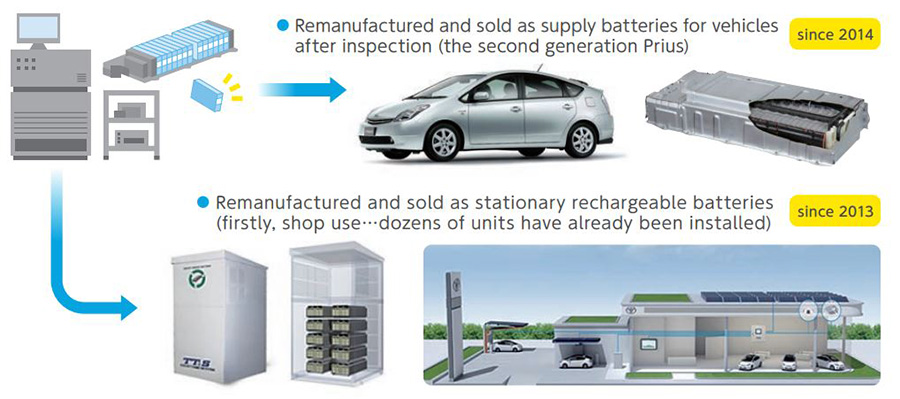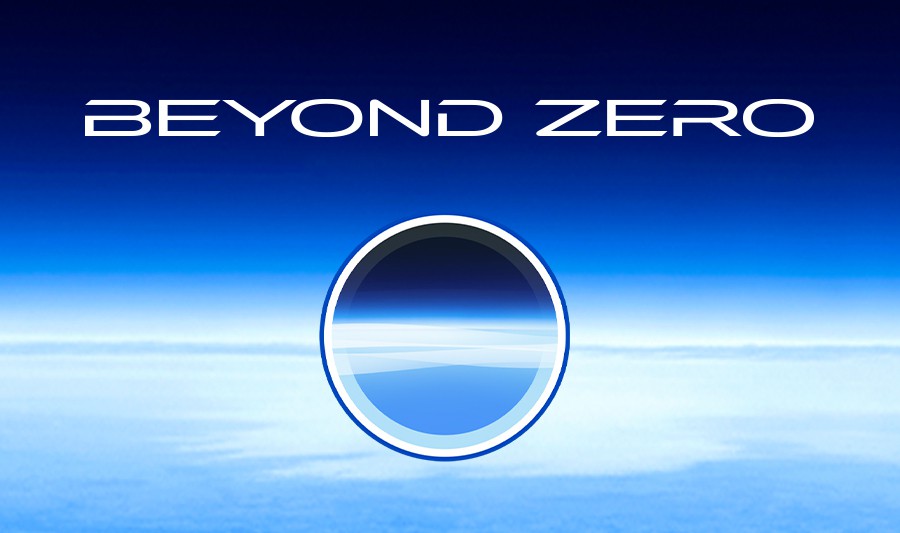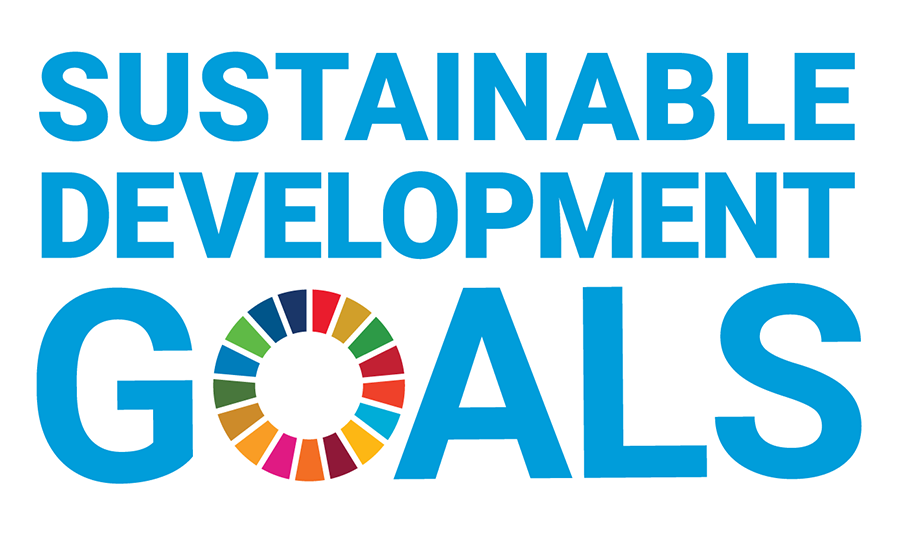As electrified vehicles become more widespread, Toyota Motor Corporation (Toyota) is promoting activities that focus on the creation of a circular economy, including a circular ecosystem for the batteries used in its vehicles, in accordance with the broader aim of achieving carbon neutrality.
Circularity is important when considering the stages of life for automotive batteries and even more so when considering the batteries used for battery electric vehicles (BEVs). Toyota’s efforts in this space include developing batteries that are resource-efficient and long-lasting during their first phase of life, so that customers can have peace of mind as they drive their cars over their term of ownership. After that, the batteries can find a second life in either automotive or non-automotive applications through reuse by repackaging (rebuilding) for the envisioned use conditions. Finally, when it is determined that they have reached their end-of-life stage, the company aims to recycle them in a sustainable way that both mitigates the amount of CO2 emitted and allows as much material as possible to be used as stock feed for new battery production.
To represent the path of circularity, the company uses the so-called “Battery 3R” and is now accelerating efforts related to what the three “R’s” represent―① Reduce, ② Rebuilt/Reuse, and ③ Recycle―globally, in collaboration with various partners, and considering the availability of local battery production in each country and region. Toyota hopes the efforts not only support vehicle development but also contribute to local communities.
Battery 3R is part of a broader environmental strategy that Toyota is employing around the globe. Toyota is emphasizing the implementation of various initiatives related to the development of its vehicles worldwide starting from the design stage, such as resource recycling, improving the durability and longevity of products, and minimizing waste, all of which are explained in the company’s recently updated Sustainability Data Book.
In 2020, Toyota formulated the Seventh Toyota Environmental Action Plan―2025 Target, an incremental action plan to achieve the Toyota Environmental Challenge 2050. Under the 2025 target, Toyota is accelerating environmental initiatives, with a strong focus on two specific initiatives
- Introducing and implementing Battery 3R throughout five regions―Japan, the U.S., Europe, China, and Asia.
- Aiming to maximize the collection and detoxification of end-of-life batteries globally.
Examples of 3R Battery Initiatives
① Reduce
Battery Innovation
As Toyota advances its efforts toward introducing next-generation BEVs in 2026, the company is developing next-generation batteries that feature new chemistries and even new physical structures. From further improving the energy density of liquid lithium-ion batteries and adopting bipolar structures for HEVs to BEVs, Toyota is expanding its lineup to provide customers with a variety of options, from low-cost, popular batteries to advanced batteries that pursue even higher performance.
Electrified Technologies – Batteries, Fundamental technologies to innovate BEV (June 13, 2023)
Improve battery-related performance of current BEVs
For its conventional BEV models, such as the bZ4X, Toyota is working to improve the vehicles by, for example, further shortening the charging time in low ambient temperatures via improvements to the battery warm-up performance in cold weather and extending the actual driving range by reducing power consumption and optimizing air conditioning control, as seen in the Japan market.
② Rebuilt and Reuse
Large-capacity sweep energy storage system with batteries for BEVs
JERA Co., Inc. and Toyota constructed a large-capacity sweep energy storage system using the drive, or traction, batteries of used electrified vehicles (HEVs, PHEVs, BEVs, and FCEVs). The constructed system enables a second use of vehicle batteries with large differences in performance and capacity in a non-automotive application.
Development and demonstration of stationary storage battery systems
Tokyo Electric Power Company Holdings, Inc. (TEPCO HD) and Toyota developed a stationary storage battery system (1 MW output, 3 MWh capacity) that combines TEPCO’s operating technology and safety standards for stationary storage batteries and Toyota’s system technology for used electrified vehicle storage batteries. Toyota Tsusho Corporation and Eurus Energy Holdings Corporation installed this system at the Eurus Tashirohira Wind Farm, with a demonstration test now underway.
② Rebuilt and Reuse, ③ Recycle
Hybrid Battery Initiatives
Currently, Toyota inspects and reassembles (rebuilds) used nickel-metal hydride batteries removed from HEVs in the Japanese market. The batteries have been reused as stationary batteries since 2013 and for vehicles since 2014.
Recent Overseas Activities
In North America, Toyota and Redwood Materials recently announced an expanded recycling agreement that aims to create pathways for automotive batteries used in Toyota’s electrified vehicles that have reached the end of their first life. An additional agreement was also entered into for Toyota to source Cathode Active Material (CAM) and Anode copper foil from Redwood’s recycling activities for Toyota’s future, new automotive battery production. These agreements build on the initial collaboration with Redwood announced last year for battery collection and recycling of Toyota’s hybrid and battery electric vehicle batteries.
For the press release regarding the collaboration with Redwood Materials, please click here
“Achieving zero, and adding new value beyond it”
As part of efforts to pass our beautiful “Home Planet” to the next generation, Toyota has identified and is helping to solve issues faced by individuals and overall society, which Toyota calls “Achieving Zero,” hoping to help reduce the negative impacts caused by these issues to people and the environment to zero. Additionally, Toyota is also looking “Beyond Zero” to create and provide greater value by continuing to diligently seek ways to improve lives and society for the future.
- About Beyond Zero
- https://global.toyota/en/mobility/beyond-zero/
Toyota Motor Corporation works to develop and manufacture innovative, safe and high-quality products and services that create happiness by providing mobility for all. We believe that true achievement comes from supporting our customers, partners, employees, and the communities in which we operate. Since our founding over 80 years ago in 1937, we have applied our Guiding Principles in pursuit of a safer, greener and more inclusive society. Today, as we transform into a mobility company developing connected, automated, shared and electrified technologies, we also remain true to our Guiding Principles and many of the United Nations’ Sustainable Development Goals to help realize an ever-better world, where everyone is free to move.
- SDGs Initiatives
- https://global.toyota/en/sustainability/sdgs/











